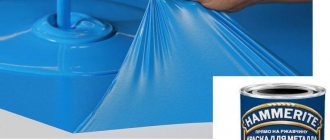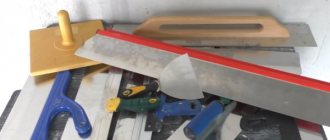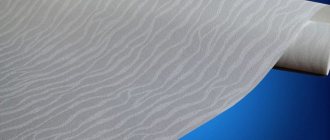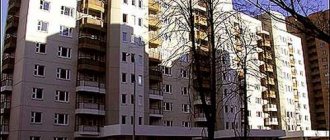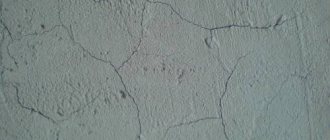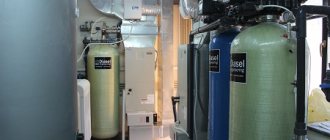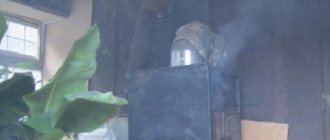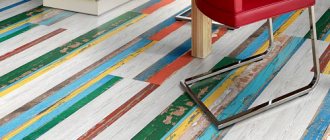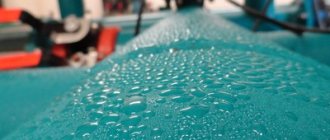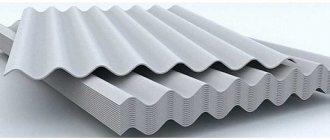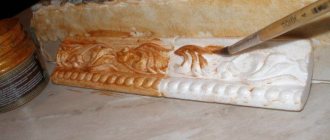Epoxy resin based paints and varnishes
Epoxy resins are used to make a huge number of materials for various applications. They are used in the radio electronics, electrical engineering, shipbuilding, aircraft and mechanical engineering industries, including as film-forming paints and varnishes, as components of impregnating and casting compounds, sealants, adhesives, etc. A wide selection of film formers allows you to create products with a wide variety of properties (for example, EP-741 varnish, HP-0064 putty). These compounds are used for anti-corrosion protection of products made of wood, concrete, plastics, metal structures and others. About 50% of the total world production of epoxy resins is used for these purposes. More details
What requirements must paint compositions meet?
When selecting paints and varnishes for painting “galvanized”, it is necessary to remember that it must necessarily have the following properties:
- The paintwork must be quick-drying;
- the material must be technologically easy to use (easy to apply in various ways, be sufficiently fluid, but not form streaks during application);
- provide long-term protection from possible negative atmospheric influences;
- the paintwork should not fade in the sun;
- the coating must have high elasticity and adhesion;
- have good hydrophobicity, ensuring resistance to precipitation in the form of rain and snow;
- the paintwork must be highly resistant to temperature changes;
- coating based on galvanized paints and varnishes must have an aesthetic appearance;
- Paintwork materials must be safe for human health and the environment.
All about modern decorative plasters
Modern decorative plasters are an excellent choice of paints and varnishes for renovation and construction of a house or apartment. Their use makes it possible to improve the appearance of structures, hide and eliminate visible defects, improve the indoor microclimate, and facilitate subsequent work. The main thing for today is to understand all the diversity presented in order to get the ideal final result. More details
What is the reason for the need for coloring?
Experts recommend using complex coatings to protect galvanized steel, i.e. the use of systems consisting of several paints and varnishes to provide two main functions:
- protective, since the zinc layer gradually becomes thinner and becomes unable to withstand atmospheric influences;
- decorative – giving the painted product the required color, texture and shine instead of the original monochromatic dull gray color, which allows for an original aesthetic appearance of both the metal structure itself and the entire building or structure.
Practice shows that it is best to paint galvanized iron after a year, during which time the “galvanization” will age naturally, i.e. its surface will acquire a roughness that improves adhesion when applying paintwork materials. If painting still needs to be done at an earlier date, then it is advisable to treat the galvanized surface with abrasives - power tools with rotating wire brushes, grinding machines or, in extreme cases, sandpaper.
The role of enamels in protection against corrosion of metal and concrete
Almost all elements used for construction purposes require additional protection with paint and varnish products. Basically, protection against corrosion of metal is required - sheet metal with a factory coating using the coil-coating method and protection of reinforcement in reinforced concrete. Recently, corrosion protection of concrete surfaces has become increasingly important; EP-140 and EP-255 enamels are used for these purposes. More details
Galvanized metal painting technology
The painting process itself includes several stages; in order to get an excellent result, you should take the time to study painting methods. And act exactly according to the recommendations.
The first stage is surface preparation, which also includes preparing the material for better adhesion to the paint. In order for the paint to adhere to galvanization, there must be small “roughness” on the surface. If the surface is smooth and there are almost no such “roughnesses” observed, they are obtained using abrasive means.
Even if the material has been standing outside for a year and has already become covered with the necessary peeling coating, it is first necessary to degrease it and get rid of contaminants.
The previously painted product is cleaned of the previous layer. To carry out cleaning, you can use a solvent, and a metal brush will help to remove the paint.
They act carefully, trying not to touch the zinc layer itself.
Even if the material has been standing outside for a year and has already become covered with the necessary peeling coating, it is first necessary to degrease it and get rid of contaminants.
Next, cleansing of contaminants is carried out. The paint is first thoroughly mixed and poured into a convenient container. It is allowed to work with any tool suitable for painting. To paint small parts, you can buy special paints in spray cans.
Before applying the 2nd layer, wait until the first one is completely dry. It is better to paint the products in two layers. Applying three layers will give a better barrier effect and the color will be bright and beautiful.
Before applying the 2nd layer, wait until the first one is completely dry.
Before painting galvanized iron, you should also take care of safety. Provided that interior work is carried out, ensure good ventilation in the room. If you have to paint a large area, then wear a respirator, protective clothing, and gloves.
Do not allow paint compositions to come into contact with flammable objects, household or any other heaters. You cannot smoke near the painting area.
If you have to paint a large area, then wear a respirator, protective clothing, and gloves.
Galvanized iron will become even more durable if you take care of additional protection with paint. Carrying out painting with your own hands is a simple process, but it is important not to forget about safety measures. It is also important to pay attention to the choice of the dye itself; this stage is the most important when working with painting galvanized iron. In order for the result of painting work to be beautiful, reliable and durable.
Waterproofing foundations and roofs
Proper waterproofing of the foundation and roof is extremely necessary as one of the stages of building a house or bathhouse. Already during the laying of the building, work should be carefully carried out on the foundation. Creating an insufficient or poor-quality water-repellent layer on it can subsequently lead to serious damage to the entire structure as a whole. More details
How to paint galvanized steel?
For painting “galvanized”, the use of traditional oil and alkyd paints is not permissible, since as a result of chemical interaction with zinc they will oxidize, which will lead to deterioration of adhesion, and, as a consequence, to swelling, peeling and cracking of the paintwork.
Khimtek-Yar LLC recommends using the following paints and varnishes for painting galvanized steel:
1. primer VL-02.
2. enamel VL-515.
3. Primer-enamel YARFAST®-0715.
When using complex coatings to protect galvanization to ensure high adhesion to the galvanized surface and good anti-corrosion properties, it is most advisable to use VL-02 primer in accordance with GOST 12707 as a primer layer.
Primer VL-02 is a mixture of two components - a base and an acid thinner. Both components are mixed immediately before application in a ratio of “base: acid thinner” = 4:1, the primer is allowed to sit for 30 minutes and then applied to the surface by brush, pneumatic or airless spray. If necessary, the primer is diluted to working viscosity with solvents 648, R-6, toluene or xylene.
VL-515 enamel is applied over the VL-02 primer coating. It is allowed to apply VL-515 enamel without prior priming, but the durability of the coating will be lower than when used in combination with VL-02 primer.
Before use, VL-515 enamel is thoroughly mixed and diluted to a working viscosity of 16 to 22 s using a VZ-246 type viscometer with a nozzle diameter of 4 mm at a temperature of (20.0 ± 0.5) °C with solvent 515.
Then the enamel is filtered through two to four layers of gauze. VL-515 enamels are applied to the surface by pneumatic spraying using any type of paint sprayer. Application by brush is allowed.
The use of primer-enamel YARFAST®-0715 allows you to avoid preliminary priming of the galvanized surface with primer VL-02 or primers of other brands. Before use, the primer-enamel is thoroughly mixed until the consistency is uniform throughout the entire volume, then left for 10 minutes until the bubbles disappear.
If necessary, the material is diluted with xylene or petroleum solvent to working viscosity.
Primer enamel is applied to the surface to be painted at an ambient temperature from plus 5 to 30 ° C and a relative air humidity of no higher than 80% in one or several layers.
The recommended thickness of the dried coating for YARFAST® primer enamels is 80–100 microns.
Important: if you use other brands of paint to paint a galvanized surface, you must remember that they must be chemically inert towards zinc in order to avoid damaging the integrity of the coating.
When using two materials for galvanizing painting - primer and enamel - you need to be sure of their compatibility with each other.
Fire protection for your wooden house and bathhouse
Wooden houses, baths, saunas are places with high humidity and fire danger. Their surfaces require additional treatment with protective compounds: fire retardants, antiseptics and special varnishes/primers. Competent fire and bioprotection of a wooden house and bathhouse allows... Read more
Acidic, phosphating, etching or reactive primer?
All these names, one way or another, refer to soil that contains acid. In English, there are three different names for acid soils, which are also indicated on packages sold in Russia. Etch or etching primer - etching primer, self etch/etching primer - etching primer, which has ingredients that immediately after the action of the acid are eaten into the metal, creating anti-corrosion protection, wash primer - reactive primer, which also contains acid and, in theory, is intended for application to new metal that does not contain old putty and paint to increase adhesion (especially non-ferrous metals, such as aluminum).
p, blockquote 4,0,0,0,0 –>
Some acidic soils are not “strong” enough to attack steel. You need to look at the technical specifications of the product.
p, blockquote 5,0,0,0,0 –>
Different manufacturers have different primer formulas and instructions for use. Initially, etching primers did not contain components that increase corrosion protection and, especially, fillers that fill small irregularities. Nowadays you can find acidic soils from different manufacturers that contain anti-corrosion additives and can be used as fillers at the same time. Most often, however, a good acidic primer is able to chemically act on any metal, preparing it for the next layer of filling primer, and also converts a small amount of difficult-to-clean rust and passivates the surface of the metal, making it inactive to oxidation, and therefore to corrosion.
p, blockquote 6,0,0,0,0 –>
What is better to use for a wooden house: tow, moss or sealant?
What is better to use for a wooden house or bathhouse: tow, moss or sealant?
This question faces everyone who builds their own wooden house. It doesn’t matter what is used to create a log house - logs or beams, there will still be gaps between them. These are the ones you should get rid of first. For these purposes, in our country it has traditionally been customary to use natural materials moss and tow. But today a new product has appeared - sealant. It is also used for insulating seams between logs and for sealing chips and cracks on wooden surfaces. More details ↑ Up
The SpetsEmal company supplies paints and varnishes for special purposes: oil-gasoline-resistant, heat-resistant, auto enamels, fire protection and many others. Please note that we also sell fire retardant materials for metal, wood, concrete, plastic, textiles. A wide selection of coatings on different bases: AK, AS, VL, FL, HP, EP, GF, KO, HS guarantees satisfaction of your needs! Special prices apply: primer bep-0237, varnish ep-730, varnish pf-170, paint ko-42t, enamel pf-1315.
Special coloring compounds
As you can see, all of the above options have certain disadvantages when working with galvanized surfaces. On the modern market there are special paints developed specifically for galvanized steel.
The best option is to use acrylic primers for galvanizing. It is both a protective primer and an enamel. The price of such a coating is higher, but the level of protection of the painted surface is much better, while the aesthetic characteristics are also excellent.
Imported paints
The most popular galvanizing paints for exterior use are roofing brands such as Hammerite and Tikkurilla. The first product is good because it can be applied even to surfaces damaged by corrosion.
Among the main advantages are:
• wear-resistant and durable coating; • high adhesion to metals; • anti-corrosion protection; • aesthetics; • drying speed; • number of available colors; • resistance to ultraviolet radiation.
Disadvantages include salt deposits that form over time, corrosion after just a few years, cracking due to insufficient degreasing, and air bubbles when applied to a metal surface with a roller.
The option from the Finnish manufacturer Tikkurilla has more advantages - it is epoxy paint and at the same time a primer for metal. Here, in addition to the above properties: a high level of resistance to weathering and chemical influences, heat resistance, the ability to be stored at low temperatures, and the ability to apply paint yourself.
The manufacturer recommends applying the coating in relatively hot weather. Hot metal promotes better adhesion.
On video: paint for metal structures from Tikkuril.
Domestic products
Along with imported materials, no less high-quality domestic products are also on sale. The most popular option is Tsikrol paint. This is a special acrylic paint composition that is designed to work with galvanized surfaces. It is based on acrylic resins with additives from polymers and organic solvents.
The material is characterized by many advantages:
• high adhesion to the surface; • high hiding power; • high level of anti-corrosion protection; • high resistance to moisture; • resistance to sunlight; • quick drying.
You can use this paint on roofs made of galvanized sheets, corrugated sheets, and tin. This composition is widely used for galvanized pipes and other structures, rolled metal.
You can apply Tsikrol paint without mandatory priming; a single layer application is sufficient.
Application of acid primer
p, blockquote 24,0,0,0,0 –>
- Before applying the phosphating primer, the surface must be especially thoroughly degreased. It is better to do this with rubber gloves so as not to accidentally leave fingerprints.
- To create good adhesion to metal, you need to apply a wet layer of acidic primer.
- It is better that the film thickness does not exceed 8 microns, otherwise adhesion will deteriorate. Usually one wet coat is sufficient.
- According to technology, acid primer is effective on “bare” metal. Getting a small amount of this primer on old paint or putty will not create a problem.
- After applying the acid primer, you need to wait about 10–20 minutes until the primer dries before applying secondary primer.
- No sanding is required before applying acrylic fill primer.
One-component acid primer
One-component acid primer does not require the addition of an activator. This primer is sold both for application with a spray gun and in cans.
p, blockquote 10,0,0,0,0 –>
p, blockquote 11,0,0,0,0 –>
Acid primer contains no fillers and dries to a very thin layer.
p, blockquote 12,0,0,0,0 –>
One thin layer is enough. Applying a thick layer or several thin layers of a one-part acid primer will not make it more effective.
p, blockquote 13,0,0,0,0 –>
It must be remembered that any one-component product is in an unstable (unhardened) state and can affect the next layer of coating. Immediately after drying, the acid primer should be coated with a two-component (with hardener) acrylic filler primer.
p, blockquote 14,1,0,0,0 –>
Wash primer
Wash primer and acid primers are similar in their action. Wash primer is applied only to bare metal. It does not fill in scratches and minor irregularities and requires the application of acrylic primer on top of it. Wash primer is phosphoric acid in a solution of polyvinyl butyral polymer, isopropyl alcohol and other ingredients. This primer is applied in a thin layer, creating a dry film 8–13 microns thick. This primer makes the painting process more efficient and adds anti-corrosion properties to the metal. In the future, during operation, even with slight damage to the paint layer, the metal treated with reactive primer will not rust.
Two-component acid primer
Two-part acid primer must be mixed with an activator to be used.
p, blockquote 15,0,0,0,0 –>
Acid primer with activator is applied in 1 layer. It is not an independent, complete soil. Secondary (acrylic) primer is applied as the next layer, after 15–20 minutes.
p, blockquote 16,0,0,0,0 –>
From experience, we can say that two-component acid primers are better at transforming rust residues remaining after cleaning and provide better protection against corrosion.
p, blockquote 17,0,0,0,0 –>
Can paint be applied to acidic soil?
The basic rule is that the acidic primer must be coated on top with a secondary acrylic primer, which, after drying, must be prepared for painting by sanding.
p, blockquote 25,0,0,0,0 –>
If a layer of paint is applied to a one-component acid primer, then one of the problems may be the effect of the yellow pigment of the primer on the paint. It may affect the color of the paint.
p, blockquote 26,0,0,0,0 –>
Overview of the features of rubber paint for galvanization
Paint for galvanized metal for exterior use is also represented by a rubber coating, which is made on the basis of acrylic. Among the distinctive features is high elasticity. After drying, the top layer of such material will resemble rubber, thanks to which the surface is not affected by mechanical forces such as impacts.
Such paints for metal surfaces are durable, resistant to chemical influences, withstand precipitation well, are environmentally friendly and have high decorative properties.
